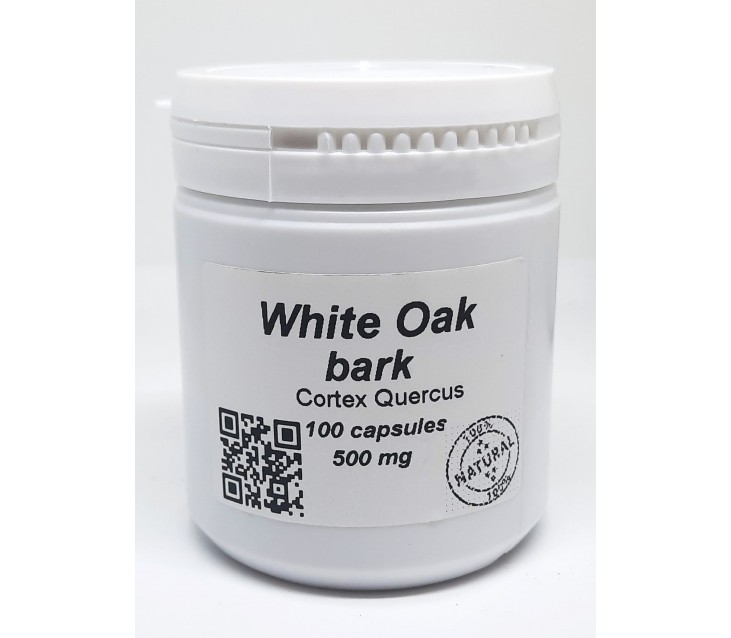White Oak Bark 500mg 100 vegetarian capsules
Lorem Ipsum is simply dummy text of the printing and typesetting industry. Lorem Ipsum has been the industry's standard dummy text ever since the 1500s, when an unknown printer took a galley of type and scrambled it to make a type specimen book. It has survived not only five centuries, but also the leap into electronic typesetting, remaining essentially unchanged.
-
White Oak Bark 500mg 100 vegetarian capsules
Chemical composition and useful components
Oak bark is well known in phytotherapy for its numerous healing properties. This effect on the body is due to its rich chemical composition. Indeed, it is this part of the tree that contains most of its active ingredients: tannins, flavonoids and catechins.
The composition of oak bark:
► tannins (15 to 20%): derivatives of gallic and ellagic acids
► pentosans (13 - 14%)
► pectin substances (up to 6%)
► quercetin
► micro and macroelements: magnesium, iron, potassium, calcium, manganese, copper, aluminum, nickel
► vitamins: PP, C, B1, B2, B6
► sugars, proteins, starch, levulin, pyrogallic substances.
The main therapeutic effect of oak bark is associated with the presence of tannins. They suppress the release of inflammatory compounds and exhibit antibacterial properties by binding to proteins involved in bacterial growth, reduce the absorption of toxins into the blood and remove highly toxic substances from the human body.
In addition, some oak bark polyphenols can act as antioxidants, protecting the body from damage caused by free radicals. It is believed that the antioxidant activity of these compounds plays a significant role in the therapeutic properties of oak bark.
The presence of gallic acid in conjunction with catechins determines the antimicrobial activity of oak bark, and quercetin blocks the production of histamine and other mediators involved in the inflammatory process, responsible for the anti-edematous effect.
Advantages and beneficial properties of oak bark
Oak is a medicinal plant, the recipes of which have stood the test of time. The astringent, anti-inflammatory and antiseptic properties of its bark have been used in herbalism and phytotherapy since time immemorial.
Benefits for oral health
Traditionally, oak bark has been used to eliminate problems with the mucous membrane of the mouth and larynx, and to treat gum disease. Thanks to tannins and antioxidants, it has the following therapeutic effects:
antibacterial: fights the proliferation of harmful bacteria
astringent: strengthens and compacts tissues
anti-inflammatory: relieves inflammation, swelling and redness
protective: creates a protective layer
regenerative: stimulates the restoration of damaged tissues.
Health products based on oak bark are widely used for diseases such as gingivitis, stomatitis, periodontitis.
One test-tube study showed that an ointment based on oak bark was effective against drug-resistant bacteria, including Staphylococcus aureus.
Soothes Diarrhea
Human studies support the use of oak bark tannins to treat diarrhea. These substances are effective in combating bacteria that cause stomach upset with loose stools, including E. coli. It has been shown that tannin compounds can be beneficial for the intestines and prevent watery stools.
A study of 60 children with acute diarrhea showed that those who received tannin supplements along with a rehydration regimen had significantly fewer stools after 24 hours compared to baseline.
Eliminates sweating
Due to its deodorizing and antiseptic properties, oak bark is a popular remedy for fungal infections, excessive sweating of the feet and hands.
Used for problem skin
Oak bark-based products have a pronounced tightening and smoothing effect, strengthen blood vessels, help reduce wrinkles, tone and regenerate tired skin.
The decoction helps with oily and problematic skin, combats increased sebum production, eliminating oily shine and narrowing pores.
Good for scalp health
Oak bark is widely used in dermatology and cosmetology, including for hair. Trichologists recommend it as a natural remedy for dandruff. Rinsing with decoctions of bark heals microcracks on the scalp, cures dandruff and dryness, gives hair shine, protects against early graying, and also prevents hair loss. More details here.
Can help digestion
Traditional medicine recommends using infusions and decoctions of oak bark to improve digestion, with flatulence, stomach ulcers, gastritis, colitis, enterocolitis, bleeding in the digestive system.
With its anti-putrefactive properties, it effectively fights pathogenic microflora, has an anti-fermentative effect, and stops the activity of pathogenic microorganisms.
Improves Liver Function
One study found that rats given oak bark extract for 12 weeks while on a high-fat, high-carbohydrate diet had improved heart and liver function compared to those who did not.
Another study of 75 adults with temporary liver failure found that those given oak bark extract for 12 weeks had significantly improved liver function tests compared to those who did not take the supplement.
Heals Wounds and Bleeding
Oak bark is a natural alternative recommended for internal and external bleeding. With astringent, antibacterial, anti-inflammatory, and soothing properties, it is effective for wounds and burns with the risk of infection, skin ulcers, and eczema.
When applied topically, oak bark promotes cellular restructuring and the elimination of pathogens. Tannins, which are part of its composition, in combination with skin proteins dry wounds, tighten tissues, healing bruises and cuts.
Lotions from a strong decoction are used in the treatment of wounds and bedsores to prevent further tissue damage and inflammation.
The medicinal use of oak bark decoctions against varicose veins, hemorrhoids and swollen vessels around the anal area is widely known.
Useful for men and women
In andrology, various forms of herbal medicine with oak bark are used in the complex treatment of prostatitis, genital infections, erectile dysfunction or premature ejaculation.
Due to its anti-inflammatory, hemostatic and astringent effects, it is also well known in gynecology. Decoctions and infusions of oak bark are recommended for the treatment of thrush, colpitis, vulvovaginitis, cervical erosion, inflammatory processes, heavy menstruation.
Free shipping !
Customer reviews
0 reviews

